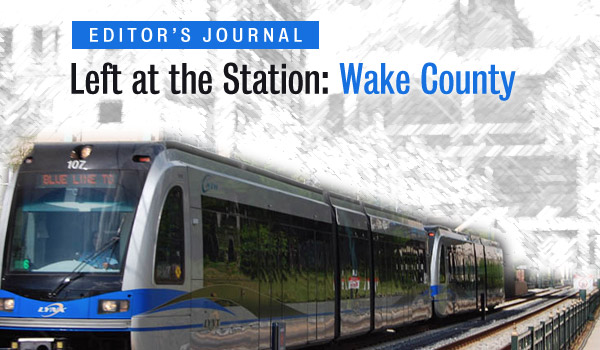Left at the Station: Wake County
Cary, NC — Good news for Durham and Orange Counties this week: the Feds have approved a plan for light rail between Durham and Chapel Hill. Left at the station without a ticket: Wake County.
Durham & Orange Rail Plans Move Forward
On Tuesday, the Federal Transit Authority gave first-step approval to a plan for 17 miles of light rail between Durham and Chapel Hill.
The next five years will see environmental, engineering and land use studies. If all goes according to plan, construction could begin and would take an additional 5 years.
The State and the Feds will pick up the majority of the $1 billion plus price tag. Durham and Orange County voters approved a half-cent ($.005) hike in the sales tax to find the project.
Wake Sleeps
Wake County voters have yet to enjoy a vote on the regional plan. Blame falls on the shoulders of the Wake County Commissioners who have stalled on a 2011 plan and refused to put the question to citizens.
Growth: It’s Coming
The Triangle is, has been, and will continue to be a hot market for growth in the United States. Population is expected to grow to 2.5 million by 2035, up from 1.6 million today, according to Capital Area Friends of Transit.
The Durham-Chapel Hill corridor (15-501) is already choked with traffic and I-40 no picnic at rush hour. With new light rail, some of the region’s growth won’t have to be borne on already heavily used roadways.
And in Wake County? More buses.
Buses are cool, but businesses will be attracted to the new rail corridor.
Light Rail and Downtown Cary
One of the biggest impediments to growth in Downtown Cary is uncertainty about plans for rail. The Triangle plans call for Phase One of local rail from Garner through Raleigh, Cary, Morrisville, RTP and up to Durham. Those trains will roll right through the Cary station at Academy and Chatham.
Private development on a significant scale will continue to stall in Downtown Cary until we know whether we are in (or out) on regional rail.
Wake: Time to Get Rolling
The Wake County Commissioners are likely to take up the issue at a retreat in Holly Springs this Friday, according to the News & Observer.
That’s good news, because we’re already several years behind our neighbors in Orange and Durham.
It is the opinion of this writer that the Wake County Commissioners should let the voters decide at the earliest possible time whether or not to join the regional rail plan with a half cent increase in sales tax.
First Google Fiber. Now regional rail. It’s starting to sound a lot like a 21st century region.
———————————————————————————————————————
Hal Goodtree is the publisher of CaryCitizen.com. Photo of light rail in Charoltte, NC by James Willamor.
———————————————————————————————————————
CaryCitizen is sponsored in part by Waverly Place.




Scott,
I’m not a great fan of ‘light rail’ either, but not all of the proposed 1/2 cent sales tax was for that purpose. Roughly half of it was supposed to be for existing transit systems, such as the C-Tran bus system.
C-Tran’s ridership has almost tripled in the last 5 years, and the system is being stressed. But, because it was supposed to get funding from the proposed sales tax, which didn’t get added to the ballot, nothing was included for C-Tran in the “Transportation Bond” passed in 2012. So instead of being able to improve service, a number of stops were eliminated in 2013, leading to the loss of at least 5 jobs I’m personally aware of. Things are at a point were there are times buses have been full to the point there is no standing room, and people were bypassed and left standing at their stop.
And, since taxes were mentioned, a look at C-Tran’s revenue numbers and the Town’s budget shows passenger ticket revenues more than pay for the Town Staff responsible for C-Tran. Unlike many other Town departments.
Scott, you will not sway their view based on facts. This is a religion to these people. Demand will never justify the need for this type system. If built it will be a financial anchor around the necks of the tax payers & there will be no significant shift to mass transit anyway.
The greatest irony of it all is that this side considers themselves to be progressive. With our mix of urban & suburban areas in the Triangle it simply won’t work. Beyond that, most futurists feel that transportation of the future will be comprised of a gps controlled vehicles driven on grid systems that will be able to move vehicles over major roads and interstates efficiently and safely & still allow the independence that only privately owned vehicles brings.
So rather than wasting billions on something that will be outdated before it’s even built lets invest in advancements in natural gas run vehicles, hydrogen fuel cells, advanced navigation systems, etc., etc. Let’s be “progressive”, we can even call it “smart growth” if that gives you warm fuzzies.
Yep. No need to bother with facts when we can convince Cary and Wake taxpayers to swallow the largest tax increase in our history, sight unseen, simply because…….
1 – Trains are cool and hip. Why else would we call it “light” rail?
2 – Durham and Chapel Hill are cool and hip, and they are doing it.
3 – A representative form of county government is good when it does what we want, otherwise we’ll just force a referendum because we know the transit and real estate industry lobbies have the dollars to sway it.
4 – If the Federal Government approves it, it must be good.
3 – Wake County Commissioners ran the numbers but we know they are not cool and hip, and do not like trains.
Not to cloud a perfectly a good agenda with facts or any semblance of objective reporting but consider what we are not being told.
1- Wake County has evolved successfully with a highly efficient, low density, car-oriented transportation system. We do not have the housing density to support light rail. When the spending spree is over, the trains will run empty and will have to be heavily subsidized for decades. The long term cost of subsidizing the operation of suburban light rail will eclipse the underestimated $1 billion construction cost.
2- Only a small percentage of city dwellers near train stations may ever benefit, yet they want all Cary and Wake County citizens to pay for their ride. If Downtown Cary businesses and residents want public transit so badly, they have a special tax district – use it to raise the money. The rest of us are happy with the efficiency, convenience, freedom, and safety of our private cars.
3- The money has not been allocated at the State and Federal levels. It may never be. Durham and Orange counties chose to commit their citizens to paying 25% of a multi billion dollar rail system with no commitment that the other 75% will ever come from the state and federal treasuries. The State budget is struggling to pull itself out of deep debt. The Federal Treasury is busy digging itself deeper into a debt hole at the rate one trillon dollars a year.
Wake and Cary continue to aggressively attract new businesses and families. The big draws? Low taxes, (for now) and hundreds of safe, high quality, single family, suburban, car friendly, family oriented, communities.
Trains in Wake are an industry solution, looking for a problem. Pursuing them is a fool’s errand.
Misery loves company, so why do we want to follow Durham and Orange off the cliff as they overtax their citizens’ and businesses’ and pour the money into the bottomless coffers of the transit industry? Let Cary and Wake continue our successful growth model, they theirs, and we’ll see who wins.
Are you listening Cary leaders? What can we do to move Downtown forward–outside of waiting on the County Commissioners to get off center–and help local business provide a boost to this flat economy? As a predicted national top-3 growth area for the next decade, it’s time for action… We’ve talked enough!
Some time back Commissioner Coble was quoted as saying “Wake County voters don’t understand what they’re voting for” when questioned about the Transportation Sales tax referendum not being put on the ballot.
And blocking that referendum to kill light rail also seriously impacted the existing transit systems, which were supposed to share roughly half of that money.
Apparently Commissioner Coble doesn’t understand that a commissioner is supposed to represent his constituents, not dictate to them after being elected.
Yep, mugshots look like they need some younger demographic types:
http://www.wakegov.com/commissioners/Pages/default.aspx
Betcha they are heavily lobbied by anti-rail John Locke, etc. Oh well.
Yeah, I’m 68.
The only solution may be to elect new commissioners who better understand how light rail is a win-win for Wake County.
While I completely agree with TJ’s comments, I must point out one inaccuracy in the original article. We, the voters of Wake County, are at fault. The Commissioners who comprise the majority anti-transit block were elected to their positions. In particular, Commissioner Paul Coble has represented a minority view of who we are in Raleigh and Wake County for decades. He has been a brake on the wheels of progress and the time for change is now. John Burns–a pro-transit candidate for County Commissioner–will file for Coble’s seat today. Volunteer for his campaign. Donate to his campaign. But most importantly, vote for John Burns and move Wake County into the 21st century.
A truly comprehensive transit solution for Wake County will include both rail and bus in order to most effectively provide alternatives to automobiles.
Such a plan, like the Core Triangle Transit Plan
http://www.wakegov.com/planning/transport/pages/transitplan.aspx
already completed with enormous stakeholder input and staff time, already exists and is ready for implementation in Wake County pending a successful voter referendum.
This incremental plan will benefit the economy, the environment and supports a better quality of life for all Wake County residents, especially the growing demographic of young professionals making up the creative class and our growing baby boomer population who are seeking a great place to settle down in preparation for eventual retirement.
It is true that not all of us will choose to use these rail and bus alternatives but many surely will and those users will reduce the burden on existing roadway infrastructure by leaving their automobiles at home and that will benefit all of us.
All that for a small sales tax which I think of as an investment in our shared future.
You are so right on, Hal!
Heck, this area even allows to buses to ride the I-40 shoulder when it is busy!
Great planning.
Sure wish the Commissioners could take a 1-day field trip (retreat?) to Charlotte, and take the electric rail to Pineville, and get a burger at the nearby Steak n’ Shake and then come back.
And, notice all the quality housing, development at the stops.